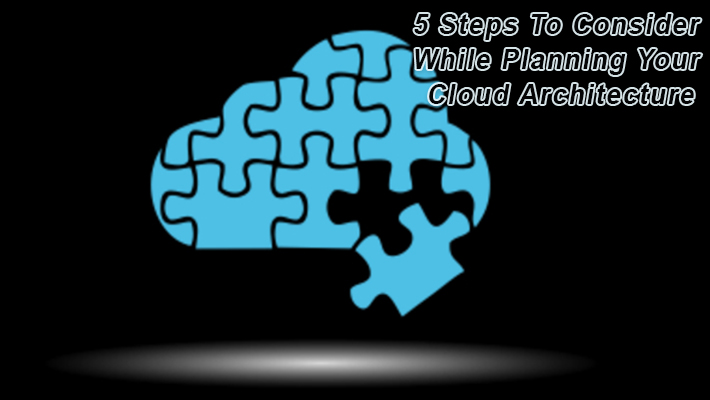
You, as a business owner, might be thinking about switching to cloud computing architecture. Few things are clear to you regarding the initial requirements- provisioning engine, a self-service portal, and some mechanism for decommissioning services. Hold on! Before you pen it down, answer these questions first - Who would all the users of this cloud be? What services would they need — and what options should he provide? How would this cloud interact with his existing systems?
Before designing and building your cloud, the first step is to constrain & define the role of cloud computing in your organization. Producing it, operating it, and consuming it, you are going to have many groups associated with the cloud effort. Engaged from the beginning or brought in later, identifying all those who will be impacted will help prevent surprises along the way for all the stakeholders.
Take into consideration, how the cloud will interact with the rest of the data center environment. Are there shared management tools, Security requirements and Compliance rules? Or is your cloud an island? Now think beyond your data center. Will you be leveraging public cloud resources, as well?
While you answer these questions, you will need to define the requirements, outline the different options, identify the costs associated with delivering each option, and create an implementation plan. Here are 5 Key steps to cloud planning:
a) Discovery and assessment
b) Service design
c) Costing and pricing
d) Planning for capacity
e) Designing the cloud architecture
Cloud Panning: Why Though?
Simple : A small IT planning saves millions of dollars and prevents failed projects, unmet expectations, and general frustration. For any business problem, before uncoiling a single network cable or procuring a single 64-way box, it only makes sense to take a step back and consider the best approach to addressing that challenge.
As far as Cloud is concerned, that problem is often labeled as “more resources faster” or “less capex on the books” or even “halting the surreptitious use of public cloud resources outside the boundaries of internal IT”.
Such statements imply some defined goals and expectations for your cloud effort. Then of course, the other primary source of motivation often comes from industry buzz. The craze around the Cloud topic has become so hot and hyped that individuals in the organization feel “someone better look into what we’re doing with cloud.” This second type of statement usually implies that there are not defined goals for the project. Nevertheless, if you wish to be successful with your cloud project, those goals should be articulated.
With the right people and the right motivations, a good cloud plan can be created in a few short weeks. Prepared with a plan, technology decisions will be easier to make, stakeholders will have properly set expectations, and the implementation team will have a strong go-ahead to move forward.
Who needs to be involved?
Not only does, Cloud planning engages the initial stakeholders in an organization, but also encompasses users from across IT and across the business. On boarding stakeholders early in the planning stage will ensure that their goals are properly represented and that you continue to get their support as the project progresses. By entertaining differing perspectives, you can also hedge against the risk of omitting key requirements that might significantly impact the group. The objective is to set the tone of incremental delivery against the cloud requirements, with collaboration along the way, when needed.
These are the Potential cloud stakeholders to consider:
a) The cloud architect, if one exists in your organization, charged with designing the cloud environment
b) The IT operations team who will look after the cloud once it is operational
c) The network team, upon whose resources and skills you will rely to network the cloud
d) The storage team, whose storage boxes will be critical to supporting cloud workloads — and for whom demand may grow significantly with this new technology
e) The applications team, who are often the de facto “users” of the cloud — unless that premise is examined
f) The capacity and performance team, whose job it will be to ensure the cloud performs as well as - or better than - the physical alternative
Other individuals within the organization can also shed light on the cloud planning process. These might include representatives from finance (who can help determine how a cloud environment is funded - and how it charges its users) and business representatives (who can help identify projects that could best utilize the cloud).
For instance, if a bank is looking to increase the transaction capacity of its online systems, the target growth numbers can help inform the capacity decision.
While it is important to consider all the stakeholders while designing a cloud, it may not be crucial to actually include all of them on an early cloud design team. Some organizations have found success by starting with a small tactical team to build out an initial cloud with future broadening and ongoing development in mind. The initial cloud offering would include only a handful of service offerings, and demonstrate the power of cloud. The small initial team would then strategically expand its membership as it further pursues long-term options.
Steps to Effective Cloud Planning
Discovery and Assessment:
- Identify existing physical and virtual resources and workloads
- Map dependencies between VMs and physical machines
- Determine the required levels of service critical to supporting the workloads
- Identify areas of potential consolidation or greater resource needs
- Locate key dependent services and multi-tiered applications
Service Design:
- Distill various platforms and offerings into a critical subset
- Identify key applications and optional services that will be offered for each type of user or role
- Determine permissions on provisioning and approval workflows
Costing and Pricing:
- Establish appropriate tailored costing model for cloud resources
- Input appropriate price information - from hardware to software and variable resources
- Determine how IT will “bill” the business, if at all, for the cloud usage
Planning for Capacity:
- Determine required capacity for existing workloads and new resources
- Evaluate required buffers to achieve service levels
- Identify physical resources to migrate into the cloud environment, and new resource investment requirements
- Consider public cloud resources to augment the capacity of the private cloud
Designing the Architecture:
- Design the new cloud architecture — from servers to storage to network topology
- Identify areas where traditional compliance, change management, and other functions could benefit the cloud environment
- Modify processes that could hamper the efficiency of the new environment
- Create a data center architecture where the cloud is not an island, but an integrated component
Though Cloud computing promises to deliver significant benefits, the road to designing and building a cloud is not always straightforward.







